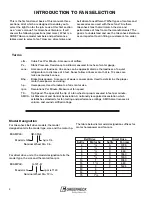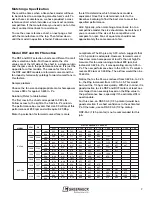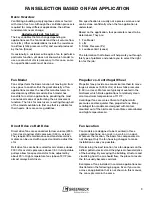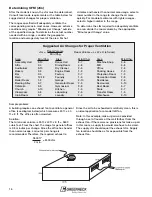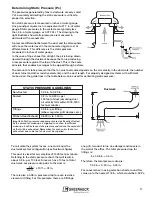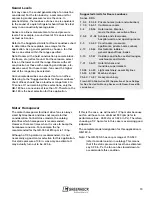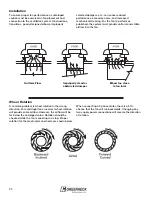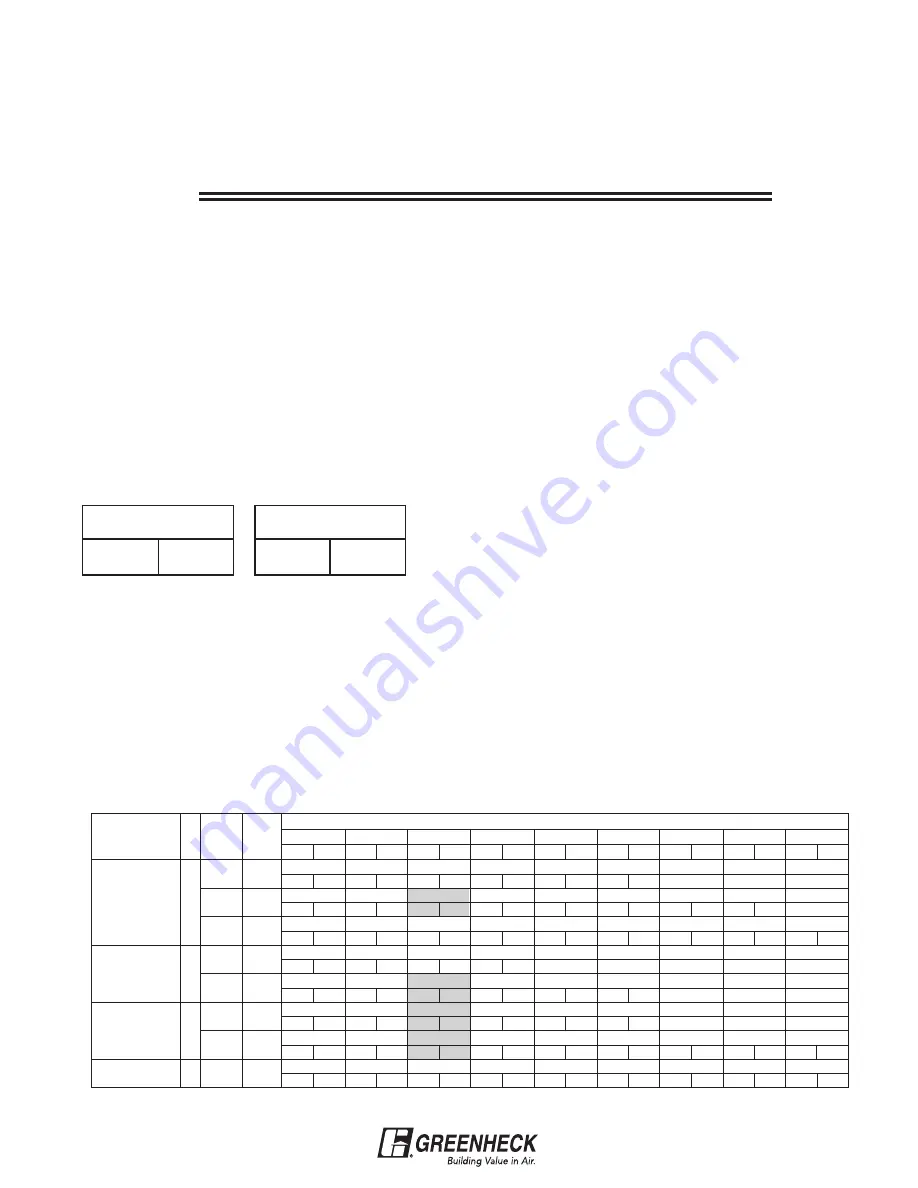
Reading Performance Charts
Assume that a job requires a belt drive roof exhauster
to move 1000 cfm against 0.25 in. Ps. Refer to the
performance model at the bottom of this page. Start at
the top of the chart with the 0.25 in. Ps column. (All
numbers in this column correspond to .25 in. Ps.) Now
follow the column downward until a value is found that
slightly exceeds 1000 cfm. In this case, 1012 cfm is the
first box that meets the requirements.
Note: Notice that each performance box is divided into
3 smaller boxes. The numbers refer to cfm, Sones and
Bhp.
Example:
At this performance point, the sone value is 11.1 and
the fan Bhp required is 0.16. Now by following the row
to the left, we can determine fan rpm and fan model.
In this case, the fan rpm is 1510 and the model is
GB-090-4 which has a 1/4 hp motor.
Notice that the GB-090-4 is not the only model to
choose from. If we follow the 0.250 in. Ps column down
further, we find a performance point at 1010 cfm.
At this point, the sone value is 7.9 and the Bhp is 0.14.
Following across to the left we find the rpm to be 1355.
The model is GB-101-4-R1, which also has a 1/4 hp
motor.
Both the GB-090-4 and the GB-101-4-R1 will perform
the air movement task equally as well. However, the
sound generated by the fan may have to be
considered. Compare the sone values: 7.9 sones for the
GB-101 and 11.1 for the GB-090. The GB-101 is about
30% quieter. Where a low sound fan is required, the
GB-101 would be a better selection. If loudness is not a
factor, the GB-090 would be a better selection because
it is less expensive.
Another possibility for this particular selection is a
GB-100-4-R2. Even though there is no performance
box showing close to 1000 cfm, there are two
performance boxes that bracket 1000 cfm. At 921 cfm
the fan will be running at 1260 rpm. At 1269 cfm the fan
will be running at 1635 rpm. Therefore, there is an rpm
for this model that will correspond to 1000 cfm
(obviously somewhere within the 1260-1635 rpm
range). As with all Greenheck belt drive fans,
intermediate cfm values are easily achieved by
adjusting the motor pulley (see illustration on next
page).
The most important part of selecting a fan is the ability
to read the performance charts. Most of the
performance charts in the catalog are similar and are
read in the same manner. Models RSF and BCF are
exceptions to this rule. The selection procedure for
these models is handled separately. Direct drive and
belt drive fans are also addressed separately.
Belt Drive Selection
CFM
Sone Bhp
1012
11.1 0.16
1030
957
884
807
725
632
10.1
0.11
9.9
0.12
9.6
0.12
9.3
0.12
8.8
0.13
8.5
0.13
1144
1078
1012
946
875
800
720
607
11.4
0.15
11.2
0.16
11.1
0.16
10.7
0.17
10.4
0.17
10.0
0.17
9.8
0.17
9.5
0.17
1295
1237
1179
1121
1061
999
934
866
785
13.4
0.22
13.3
0.23
13.2
0.23
13.0
0.24
12.7
0.24
12.4
0.25
12.1
0.25
11.8
0.25
11.6
0.25
906
818
731
607
6.0
0.060
5.4
0.065
5.0
0.070
4.3
0.070
1148
1077
1010
943
856
739
8.5
0.12
8.1
0.13
7.9
0.14
7.8
0.14
7.2
0.14
6.8
0.14
1067
991
921
840
735
385
7.6
0.099
7.1
0.104
6.8
0.112
6.5
0.115
5.9
0.115
4.4
0.083
1385
1325
1269
1214
1161
1094
1019
928
792
11.1
0.22
10.8
0.22
10.4
0.23
10.2
0.24
9.8
0.25
9.3
0.25
8.9
0.25
8.4
0.25
7.8
0.24
1525
1471
1418
1367
1320
1270
1208
1141
1064
13.2
0.29
12.8
0.30
12.5
0.30
12.3
0.31
12.2
0.33
11.3
0.33
10.8
0.33
10.6
0.33
10.1
0.33
STATIC PRESSURE / CAPACITY
0.000
0.125
0.250
0.375
0.500
0.625
0.750
0.875
1.000
Sone Bhp Sone Bhp Sone Bhp Sone
Bhp Sone
Bhp Sone
Bhp Sone
Bhp Sone
Bhp Sone
Bhp
MODEL
(rpm RANGE)
RPM
TS
1360
3983
1510
4422
1710
5008
1070
3116
1355
3946
1260
3669
1635
4761
1800
5242
hp
GB-090-4
(1290-1710)
GB-101-4-R1
(1020-1400)
GB-101-3
GB-101-4-R2
(1260-1635)
1/4
1/4
1/4
1/3
5
Table 2




